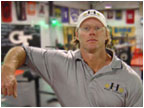 By Kurt Hester
By Kurt Hester
Every coach knows that speed is the most dominate factor in sport. Coaches recruit fast athletes and design their offenses and defenses with that speed in mind. If these afore mentioned assumptions are correct, then, why are strength coaches training these same athletes to become slow and un-explosive.Training an athlete to become faster is not relegated to speed work on the field. You don't take a highly recruited, gifted and genetically superior athlete into the weight room and do nothing to improve his speed and
explosive capabilities. Whether it is intentional or unintentional, strength coaches around the country are training their athletes in the weight room to become slower.
This is not an attack on training philosophy. It is an attack on the lack of common sense in the strength field. No matter what your training philosophy - Power lifting, Body-building, Olympic lifting or High intensity training, you can improve your program with a little common sense.
CST (Common Sense Training)
Rule #1
Train for strength not endurance. Remember your training for strength not a triathlon. Don't spend an extreme amount of time in a hypertrophy phase or endurance training. Train at five reps and
below at eighty percent and above. Do this as soon as possible in your training cycle. You have to be strong to run fast, so why train above six reps? Your goal is to get strong - to run fast, not to lift long - to run slow and long.
Rule #2
Train explosively. Olympic lifts train the athlete to explode and use maximum possible force. Athletes will develop a high rate of force, a key point in sports training. Athletes who implement these lifts in their lifting program will train fast twitch muscle fibers, the fibers employed to give you speed, explosiveness and power. In essence performing an Olympic lift is performing a fast, explosive weighted jump. Sprinting in essence is a series of fast, explosive bounds. These lifts will directly help an athlete run faster Implement lifts such as: power clean, hang clean, power snatch, hang snatch, split jerk and jerk from the rack. The amount of weight does not matter as much as bar speed.
Rule #3
Train your VMO. Training the vastus medialis will help decrease ground contact time which is crucial to increase speed. Incorporate exercises such as: chain back squat, chain front squat, walking lunge and split squat into your program.
Rule #4
You need hamstring and low back strength. Because the back squat is one of the test for lower body strength in most programs, strength coaches sometimes over look the hamstrings and lower back. The hamstrings are connected to the glutes and back extensors. This is through the sarco-tuberal and dorso-sacral ligaments All lower body workouts should involve exercises for both the hip extension function and the knee flexor function Knee flexion exercises: leg curls and glute/ham raise. Hip extension exercises: Romanian deadlift, goodmorning reverse hyper and back extensions.
There are coaches with superior educations and impressive resumes who either over think while writing their cycle or under think while writing their cycle. When all else fails just use some common sense..



